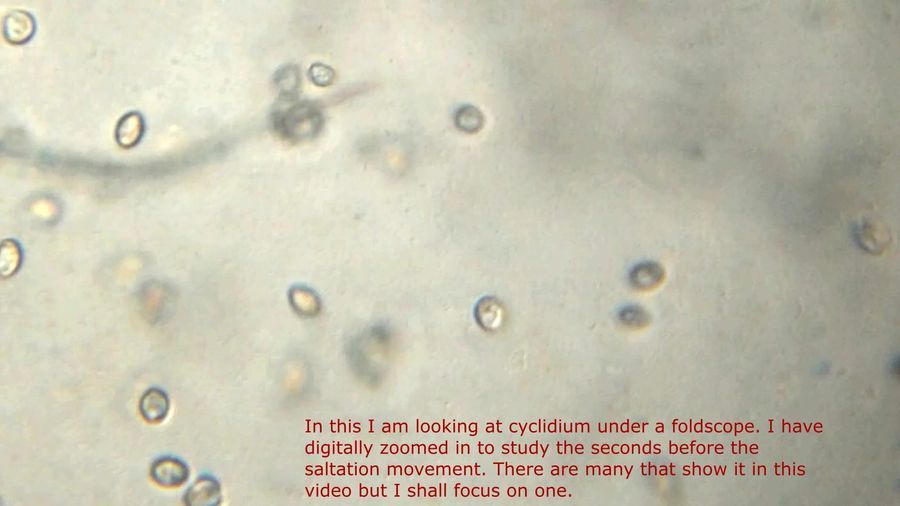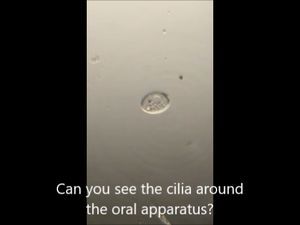Ciliate motion: Saltation and its possible reversal in Cyclidium
 Feb 14, 2019 • 12:43 PM UTC
Feb 14, 2019 • 12:43 PM UTC Unknown Location
Unknown Location 140x Magnification
140x Magnification Microorganisms
Microorganisms
laksiyer
Human observer of life. https://sukshmadarshin.wordpress.com
97posts
1255comments
5locations

One aspect that strikes you when you look at microbial life is the range of types of motion. It is what brings out the oohs and aahs to people around you. Each type of motion is a product of finding a solution to the Reynold’s number problem (Its like swimming in jelly for these critter), escape from predators, catching up with prey, chemotaxis, communications through hydrodynamic waves, and millions of years of selection of the motility apparatus. With so many parameters possibly governing the evolution of this, it isnt surprising to find very many solutions to the motion problem.
Lets take the case of Cyclidium . This is a little ciliate that is often used as food for larger ciliates and it shows a particular type of motion called saltation. Saltation is derived from the Latin Saltare to dance which is what is called a frequentative in grammar (repetitive action) of a verb called salire (to leap). Let us take a look at this Cyclidium dance.
Lets take the case of Cyclidium . This is a little ciliate that is often used as food for larger ciliates and it shows a particular type of motion called saltation. Saltation is derived from the Latin Saltare to dance which is what is called a frequentative in grammar (repetitive action) of a verb called salire (to leap). Let us take a look at this Cyclidium dance.
Cyclidium saltation motion at low power. Ok so lets take a deeper look at this, can we spot any hints that a C yclidium would saltate or not?
So did you notice anything of note? In the 400x view there was a point where a Cyclidium zooms through the field and then the one in focus zips off— is this a coincidence or do hydrodynamic waves influence movement? Why should an organism saltate in the first place? Perhaps it is a way to avoid a predator by just zooming away at random (prevent being stalked!)? Any motion is an investment of energy. Perhaps like my cell phone battery, the Cyclidium ATP potential rises and then at a critical concentration it is used for motion and then it stops and takes a breath, i.e. build the ATP potential again? Could we try something to alter this motion? With all this in mind (some 6 months ago), I did an experiment in my flight of fancy. I mixed Cyclidium with Tetrahymena vorax, an organism that I seem to grow very easily at home and look what happened!!
Why did that happen? Is this an artifact? Are those not Cyclidiums but some mini form of T. vorax ? In reality, C yclidium h as a very tell-tale sign of growth. It throws out so much “waste” that the plate often gets opaque after about 10 days and this plate was surely doing so. Like most things done in a home lab, I left the experiment on for a few days and then I got this.
Now we know from prior work that Tetrahymena vorax can be induced to transform to the macrostome form in the presence of Tetrahymena thermophila . It now appears that this can also happen with Cyclidium . Notice that all the Cyclidium is gone.
Lot of things to think about. I am really interested in knowing your thoughts below in the comments. Perhaps a better experiment can be done? Perhaps there is a logical flaw in this type of reasoning? It definitely needs to be repeated.
Lot of things to think about. I am really interested in knowing your thoughts below in the comments. Perhaps a better experiment can be done? Perhaps there is a logical flaw in this type of reasoning? It definitely needs to be repeated.
Sign in to commentNobody has commented yet... Share your thoughts with the author and start the discussion!

 0 Applause
0 Applause 0 Comments
0 Comments_300x300.jpeg)

















